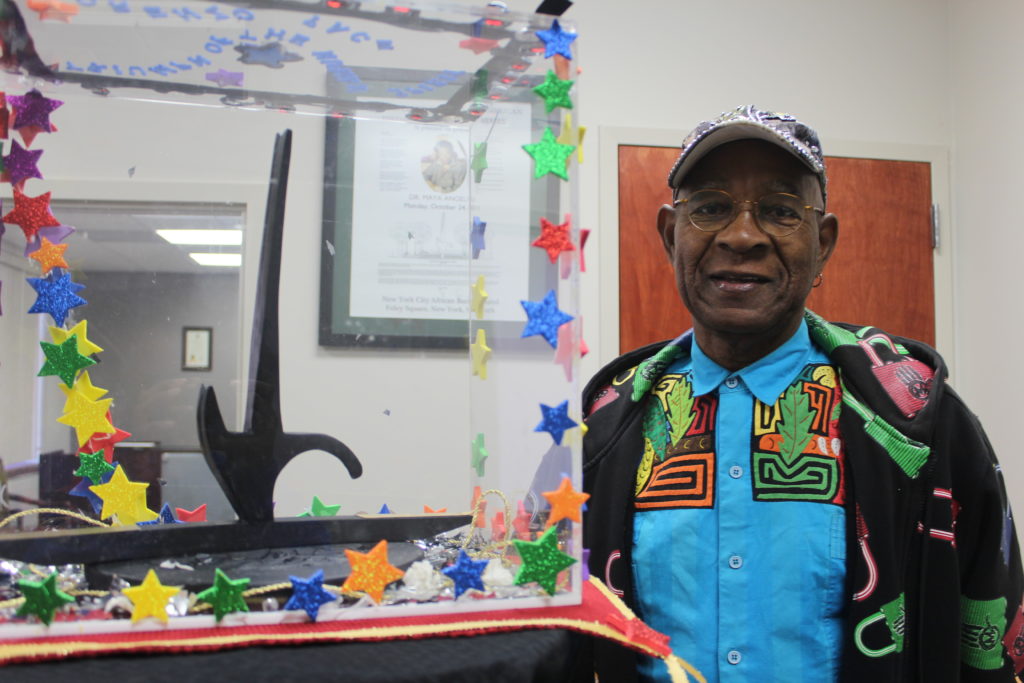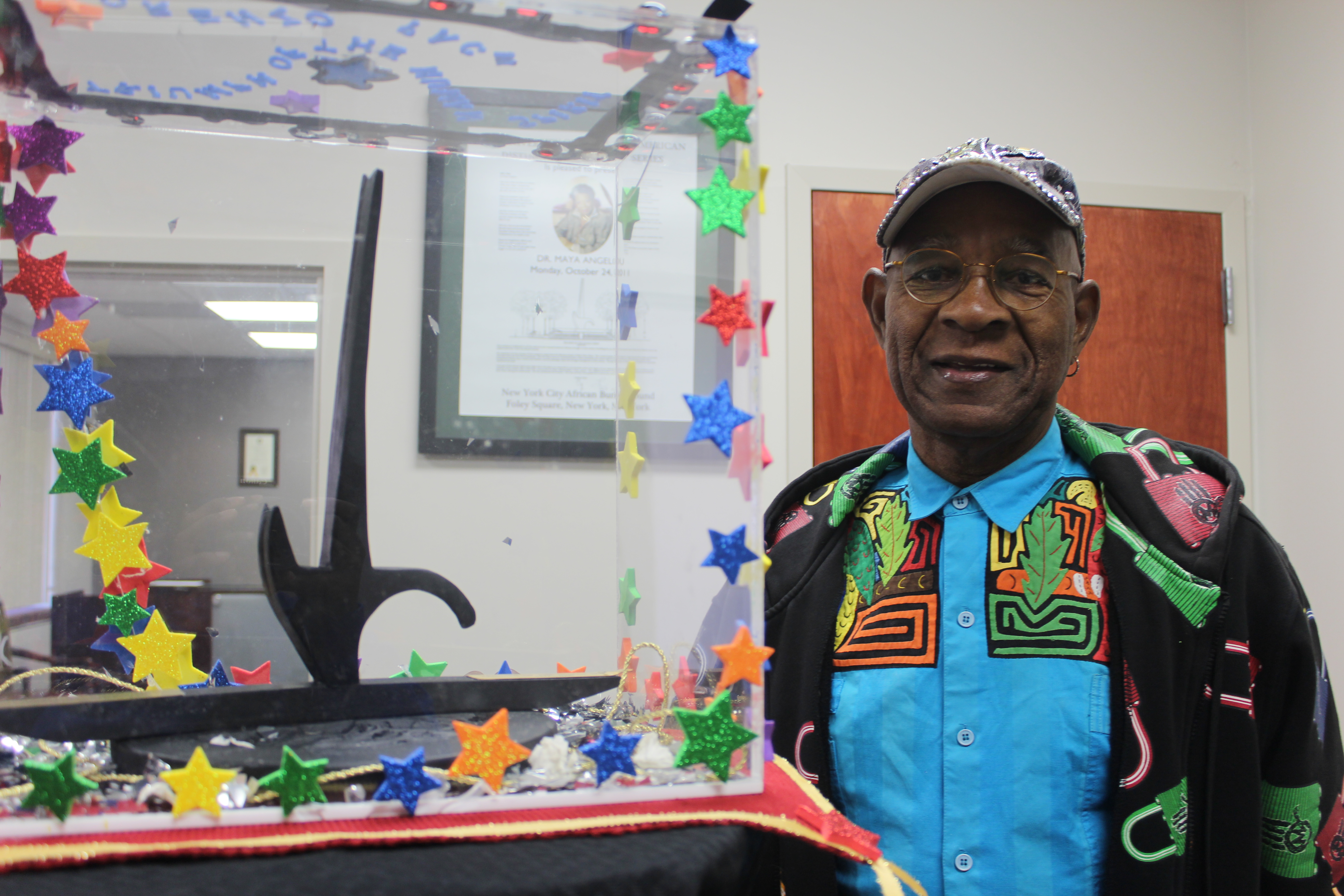By Ariel Worthy
The Birmingham Times

Birmingham native Lorenzo Pace was present when Richard Arrington took office as the city’s first elected African-American mayor in 1979 and when Randall Woodfin was sworn in as the city’s 30th mayor last week. Pace, 74, an internationally recognized artist, brought gifts for both men.
For Woodfin, Pace shaped a replica of the “Triumph of the Human Spirit,” an outdoor abstract sculpture that is installed at Foley Square in New York City. The original, a monument to honor a Colonial-era African-American burial ground in Manhattan, N.Y., is five stories high, weighs 300 tons, and is the largest monument dedicated to African-American enslavement. It was completed in 2000.
When the remains of more than 400 African slaves were excavated during the construction of a federal building in New York City’s financial district in 1991, the city wanted to create a memorial, and Pace—whose sculptures, installations, and performance art have been exhibited across the globe—was chosen to contribute to the project.
“It took me 10 years to make,” he said in an interview with The Birmingham Times. “It’s made out of granite, which is very difficult to carve.”
“Triumph of the Human Spirit” includes several meaningful symbols, such as a replica of a lock that shackled Pace’s great-great grandfather, Steve Pace, during slavery. It also features the Chiwara, a mask from Mali culture that symbolizes an antelope and has many meanings, one being that the female Chiwara carries a baby on its back and “carries the next generation,” according to Pace.
Pace said Woodfin’s election “has the same symbol of the Chiwara, the next generation, and it’s very crucial for Birmingham.”
When Arrington was elected, Pace presented the mayor with a sculpture named “Man of Courage.”
“This sculpture was to honor him, to let him know that I was impressed, [seeing] him to go through the long struggle to be mayor,” said Pace.
World Renowned
Pace, who is from Pratt City, is a world-renowned artist whose works have been on display in New York City, as well as in countries including China, Brazil, Senegal, Suriname, Peru, France. He also has been featured in several publications, including the New York Times and NY Arts Magazine.
His family moved from Birmingham to Chicago, where Pace graduated from high school. Then he moved to New York City and at 19 began traveling the world, visiting 10 African countries, Amsterdam, South America, and France, to name a few places he’s been.
“I didn’t know I wanted to be an artist until I went to Paris, France,” he said. “I’d go to the parks, and art, music, dance, creative people were running around everywhere. I went to see the “Mona Lisa” and all the great [works of] artists of the past. When I came back [to the States], I was a completely different person. I hung out with musicians, poets, writers, dancers, and it made me want to be a creative individual.”
Pace was one of the artists featured in the 2008 Beijing Olympics, for which he was selected to represent the United States via a concept called “One World, One Dream.”
“I brought 100 mops and 100 brooms, painted them white, black, and red, and infused them together to say ‘One World, One Dream,’” he said.
Pace’s passion goes beyond the visual art he creates.
“I didn’t know I wanted to be an artist until I hit my passion,” he said. “When you hit your passion, you can go in any direction you want. You have to set your mind to it, though. You have to stay strong and really find your passion, and be devoted to working with the community and in the community.”
Wordsmith
Pace is also the author of four children’s books, including “Marching with Martin,” “Harriet Tubman and My Grandmother’s Quilts,” “Frederick Douglass and the North Star,” and “Jalani and the Lock,” which was described by Publisher’s Weekly as a “stunning debut” and chosen as a Best Book by the Los Angeles Times. All of Pace’s books are personal, but “Jalani and the Lock” has even greater meaning for a few reasons.
Pace has a particular affinity for locks, which he explained his interview with The Birmingham Times. “In 1991, my father passed away. After we buried him, we were all sitting around at the repast, and my uncle asked my mother if she had a brown bag he had given my father. My mother knew exactly what he was talking about, so she gets the bag. My uncle opens [the bag] and pulls out this lock. He explains that it was given by his father, which was given by his father, Steve Pace, the slave in our family. Everybody was like, ‘Wow!’ We didn’t know the history behind the lock.”
The family gave the lock to Pace, who was living in New York City at the time. When he returned from his father’s funeral, he learned of the burial grounds and began working on “Triumph of the Human Spirit”—and he replicated the lock that shackled his grandfather at the base of the monument.
Another family incident that inspired him to write “Jalani and the Lock” (published in four languages: English, Dutch, French, and Spanish) was a conversation with his daughter.
“My daughter [Esperanza], who was about 8 at the time, came home one day and asked, ‘Daddy, are we from slaves?’ She said, ‘The kids were making fun of me because of my hair, nose, lips, and skin.’ I had to explain to her that she didn’t have to be ashamed of her hair, skin, or lips.”
The book, published in 2001, is about a young boy, Jalani, named after Pace’s son, who comes to America as a slave and is eventually set free. The book explains how blacks got to America.
Motivation
Pace, who recently retired from his position as an art professor at the University of Texas–Rio Grande Valley, will be moving back to Brooklyn from Texas soon.
“My family was part of the great migration, moving up North to escape the racism in the South,” he said. “I was a teen in high school when we got to Chicago, and we discovered that it was just as racist there as it was in Alabama.”
Pace is known around the world as a master storyteller and performance artist, and his presentations are full of music, singing, dancing, joy, and laughter. He also has served as director of the Montclair State University Art Gallery in New Jersey, and he maintains a studio in Brooklyn, N.Y.
Asked what motivates him to create art, he has said, “The precious opportunity to inspire others to think higher, deeper, and larger; to think about the value and necessity of caring for themselves, others, and our planet; to think simply of other ways of being, seeing, learning, loving, and manifesting a greater degree of peace in our world.”




